二维平面中,图像的几何变换有等距、相似、仿射、投影等,如下所示:
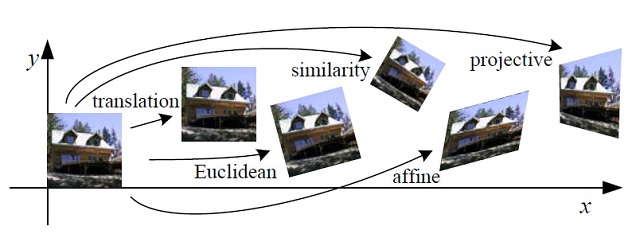
1 图像几何变换
1.1 等距变换
等距变换 (Isometric Transformation),是一种二维的刚体变换,可理解为旋转和平移的组合
$\quad \begin{bmatrix} x^{\prime} \\ y^{\prime} \\ 1 \end{bmatrix} = \begin{bmatrix} \cos \theta & -\sin \theta & t_x \\ \sin \theta & \cos \theta & t_y \\ 0&0&1 \end{bmatrix} \begin{bmatrix} x \\ y \\ 1\end{bmatrix} =\begin{bmatrix} R_{2 \times 2} & T_{2 \times 1} \\ 0_{1 \times 2} & 1_{1 \times 1} \end{bmatrix} \begin{bmatrix} x \\ y \\1 \end{bmatrix}$
其中, $R=\begin{bmatrix} \cos \theta &-\sin\theta \\ \sin \theta & \cos \theta \end{bmatrix}$ 为旋转矩阵, $T=\begin{bmatrix}t_x \\ t_y \end{bmatrix}$ 为平移矩阵
想象一个无限大的平面上,放一张极薄的图片,让它只能在平面内做旋转和平移运动,则这样的运动就是等距变换
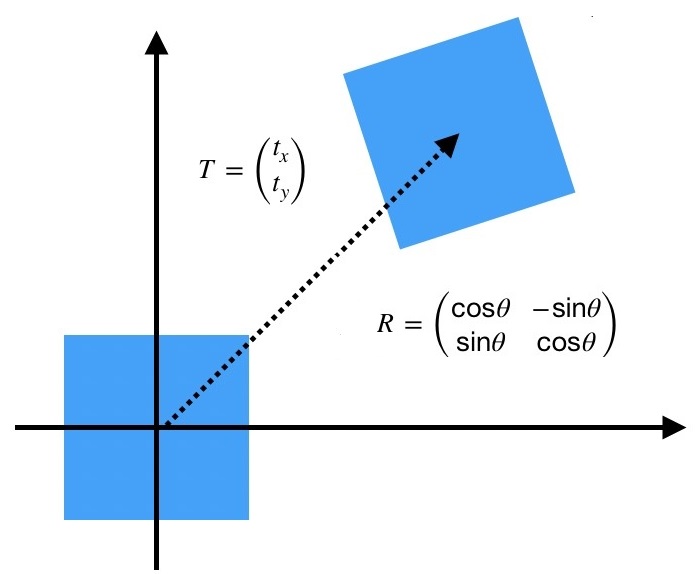
1.2 相似变换
相似变换 (Similarity Transformation),是一个等距变换和各向均匀缩放的组合
$\quad \begin{bmatrix} x' \\ y' \\ 1 \end{bmatrix} = \begin{bmatrix} s \cos \theta & -s\sin \theta & t_x \\ s \sin \theta & s \cos \theta & t_y \\ 0&0&1 \end{bmatrix} \begin{bmatrix} x \\ y \\ 1\end{bmatrix} = \begin{bmatrix} sR_{2 \times 2} & T_{2 \times 1} \\ 0_{1 \times 2} & 1_{1 \times 1} \end{bmatrix} \begin{bmatrix} x \\ y \\1 \end{bmatrix}$,其中 $s$ 为缩放系数
想象平面内的一张图片,在旋转和平移的过程中,其大小也会均匀缩放(各个方向),则这样的变换就是相似变换
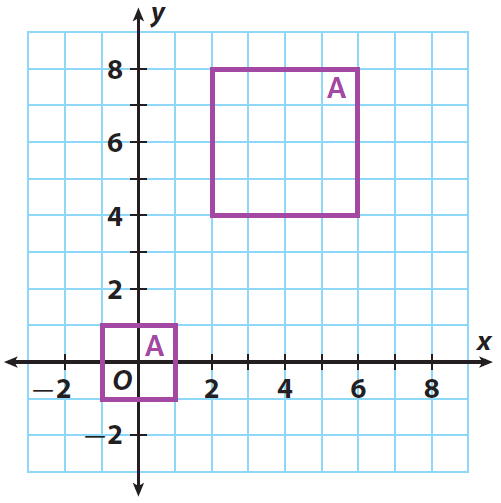
1.3 仿射变换
1.3.1 定义
仿射变换(Affine Transformation),是一个非奇异线性变变换 (矩阵乘法) 和 平移变换 (向量加法) 的组合
矩阵表达式为 $\quad \begin{bmatrix} x' \\ y' \\ 1 \end{bmatrix} = \begin{bmatrix} a_{11} & a_{12} & t_x \\ a_{21} & a_{22} & t_y \\ 0 & 0 & 1 \end{bmatrix} \begin{bmatrix} x \\ y \\ 1 \end{bmatrix} =\begin{bmatrix} A_{2 \times 2} & T_{2 \times 1} \\ 0_{1 \times 2} & 1_{1 \times 1} \end{bmatrix} \begin{bmatrix} x \\ y \\1 \end{bmatrix}$
其中,当 $A = \begin{bmatrix} a_{11} & a_{12} \\ a_{21} & a_{22} \end{bmatrix}$ 是非奇异时,称 $A$ 为仿射矩阵
1.3.2 分解
仿射矩阵 $A$ 可分解为:旋转和各向 (正交) 非均匀缩放
$\quad A = R(\theta) R(-\phi) D R(\phi)$,其中 $D = \begin{bmatrix} \lambda_1 & 0 \\ 0 & \lambda_2 \end{bmatrix}$是一个对角矩阵
首先,旋转角度 $\phi$;然后在 $x$ 和 $y$ 方向上 (其中 $x\perp y$) 分别缩放 $\lambda_1$ 和 $\lambda_2$;再旋转角度 $-\phi$,也即回转 $\phi$;最后旋转角度 $\theta$
本质上,平面中的仿射变换,就是奇异值分解的过程:$A=UDV^T$
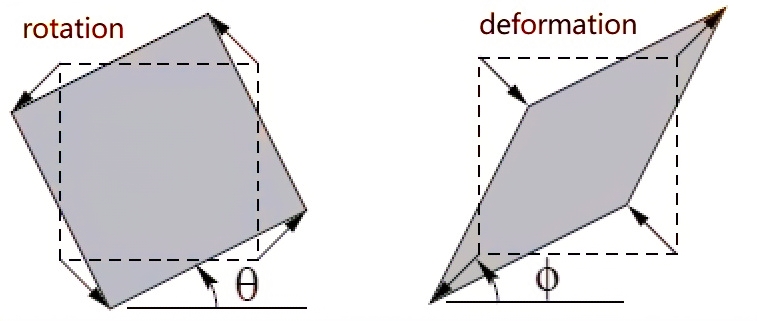
想象无限大光滑平面内的一张图片,在旋转和平移的过程中,其大小在正交方向上非均匀缩放,则这样的变换就是仿射变换
1.3.3 不变量
仿射变换的过程中,有三个重要的不变量,分别是:平行线,平行线段长度比,面积比
2 OpenCV 函数
2.1 矩阵 - 相似变换
对于相似变换,有 4 个未知数 ($s, \theta, t_x, t_y$),对应 OpenCV 中的 getRotationMatrix2D() 函数
Mat getRotationMatrix2D (
Point2f center, // 原图像中的旋转中心点
double angle, // 旋转角度(正值代表逆时针旋转)
double scale // 均匀缩放系数
)
该函数可得到如下矩阵:
$\begin{bmatrix} \alpha & \beta & (1- \alpha ) \cdot \texttt{center.x} - \beta \cdot \texttt{center.y} \\ - \beta & \alpha & \beta \cdot \texttt{center.x} + (1- \alpha ) \cdot \texttt{center.y} \end{bmatrix}$
其中, $\alpha=scale \cdot \cos angle$
$\beta=scale \cdot \sin angle$
2.2 矩阵 - 仿射变换
仿射变换有 6 个未知数 ($\phi, \theta, \lambda_1, \lambda_2, t_x, t_y$),需列 6 组方程,而一组对应特征点 $(x,y)$ -> $(x′,y′)$ 可构造 2 个方程,因此,求解 6 个未知数,需要 3 组对应特征点
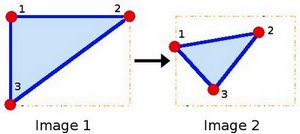
OpenCV 中 getAffineTransform() 可求解 2x3 矩阵 $\begin{bmatrix} a_{11} & a_{12} & t_{x} \\ a_{21} & a_{22} & t_y \end{bmatrix}$
Mat getAffineTransform (
const Point2f src[], // 原图像的三角顶点坐标
const Point2f dst[] // 目标图像的三角顶点坐标
)
其代码实现比较简单,先构建方程组,再利用 solve() 求解 $Ax=b$
Mat getAffineTransform(const Point2f src[], const Point2f dst[])
{
Mat M(2, 3, CV_64F), X(6, 1, CV_64F, M.ptr());
double a[6 * 6], b[6];
Mat A(6, 6, CV_64F, a), B(6, 1, CV_64F, b);
for (int i = 0; i < 3; i++)
{
int j = i * 12;
int k = i * 12 + 6;
a[j] = a[k + 3] = src[i].x;
a[j + 1] = a[k + 4] = src[i].y;
a[j + 2] = a[k + 5] = 1;
a[j + 3] = a[j + 4] = a[j + 5] = 0;
a[k] = a[k + 1] = a[k + 2] = 0;
b[i * 2] = dst[i].x;
b[i * 2 + 1] = dst[i].y;
}
solve(A, B, X);
return M;
}
2.3 变换后图象
已知仿射变换矩阵 M ,利用 warpAffine() 函数,可得变换后的图像:$\texttt{dst} (x,y) = \texttt{src} ( \texttt{M} _{11} x + \texttt{M} _{12} y + \texttt{M} _{13}, \texttt{M} _{21} x + \texttt{M} _{22} y + \texttt{M} _{23})$
void warpAffine(
InputArray src, // 输入图象
OutputArray dst, // 输出图像(大小为 dsize,类型同 src)
InputArray M, // 2x3 矩阵
Size dsize, // 输出图像的大小
int flags = INTER_LINEAR,
int borderMode = BORDER_CONSTANT,
const Scalar& borderValue = Scalar()
)
3 代码示例
首先构造3组三角顶点坐标,代入 getAffineTransform() 得到仿射变换的矩阵;再用 getRotationMatrix2D() 构造相似变换的矩阵;
然后,warpAffine() 求解经过相似变换和仿射变换的图像;最后,显示对比变换后的目标图像
#include "opencv2/imgproc.hpp"
#include "opencv2/imgcodecs.hpp"
#include "opencv2/highgui.hpp"
using namespace cv;
int main()
{
// 1) read image
Mat src = imread("horse.jpg");
// 2) triangle vertices
Point2f srcTri[3];
srcTri[0] = Point2f(0.f, 0.f);
srcTri[1] = Point2f(src.cols - 1.f, 0.f);
srcTri[2] = Point2f(0.f, src.rows - 1.f);
Point2f dstTri[3];
dstTri[0] = Point2f(0.f, src.rows * 0.33f);
dstTri[1] = Point2f(src.cols * 0.85f, src.rows * 0.25f);
dstTri[2] = Point2f(src.cols * 0.15f, src.rows * 0.7f);
// 3-1) getAffineTransform
Mat warp_m1 = getAffineTransform(srcTri, dstTri);
// 3-2) getRotationMatrix2D
Mat warp_m2 = getRotationMatrix2D(Point2f(0.5*src.cols, 0.5*src.rows), 45, 0.5);
// 4) warpAffine image
Mat dst1,dst2;
warpAffine(src, dst1, warp_m1, Size(src.cols, src.rows));
warpAffine(src, dst2, warp_m2, Size(src.cols, src.rows));
// 5) show image
imshow("image", src);
imshow("warp affine 1", dst1);
imshow("warp affine 2", dst2);
waitKey();
}
结果对比如下:
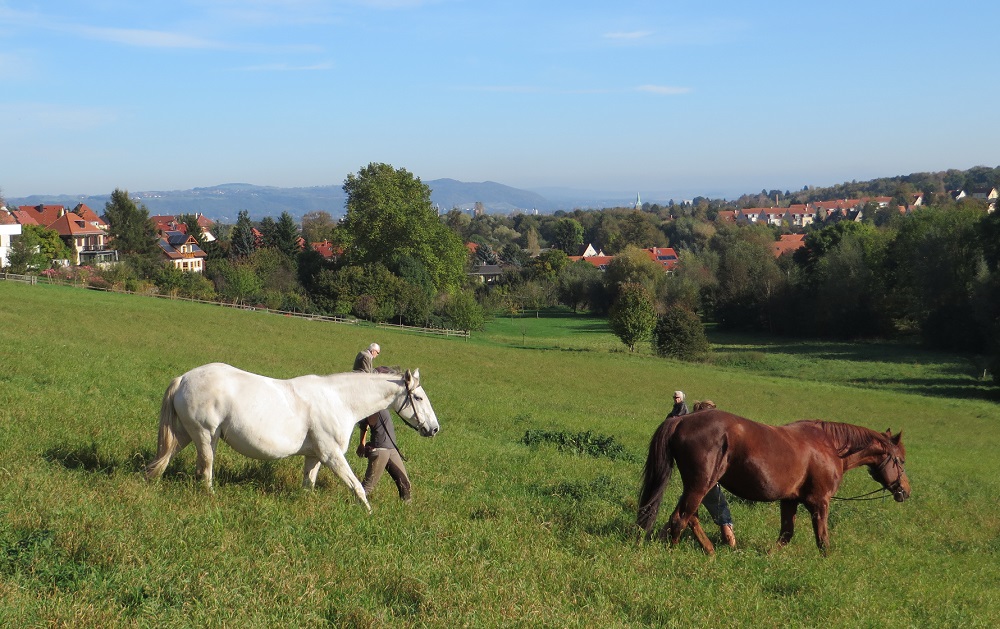
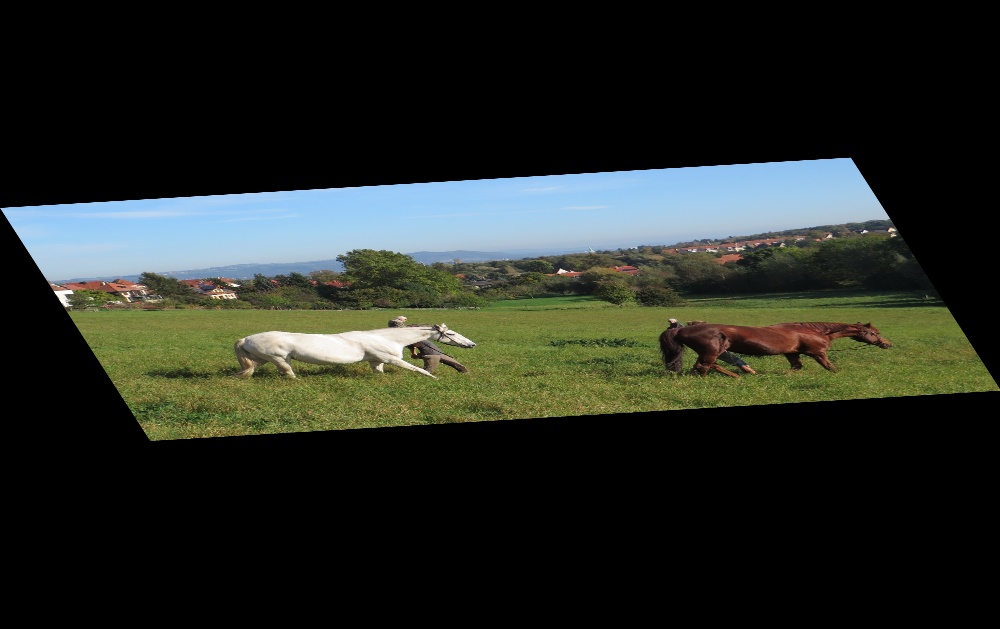
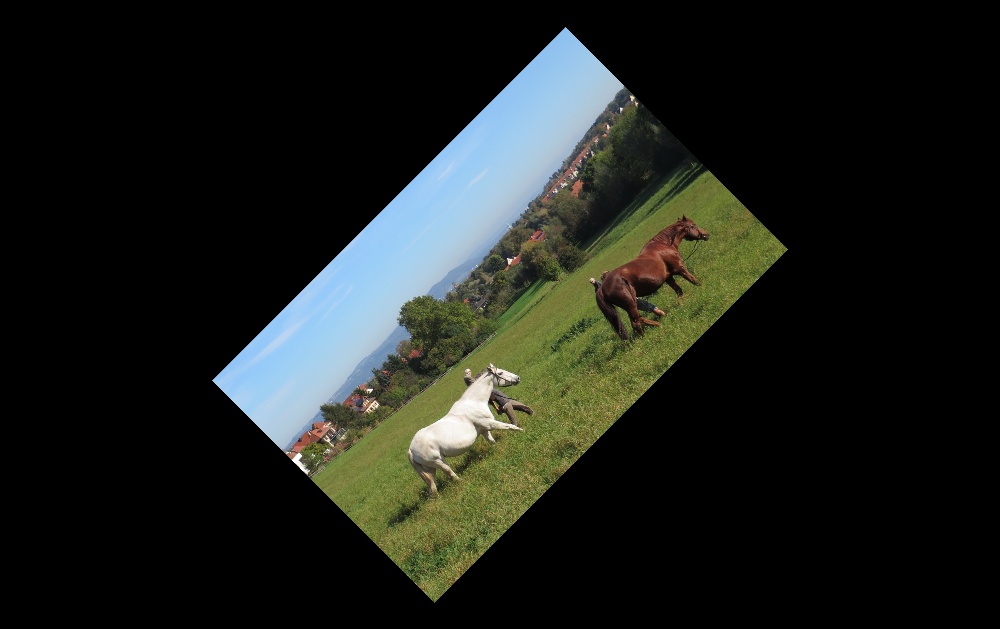
参考
《Computer Vision: Algorithms and Applications》 Chapter 2 Image Formation
《Multiple View Geometry in Computer Vision》 2.4 A hierarchy of transformations
OpenCV Tutorials / Image Processing (imgproc module) / Affine Transformations
OpenCV-Python Tutorials / Image Processing in OpenCV / Geometric Transformations of Images
原文链接: http://www.cnblogs.com/xinxue/
专注于机器视觉、OpenCV、C++ 编程



 浙公网安备 33010602011771号
浙公网安备 33010602011771号